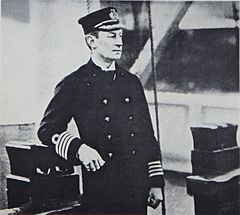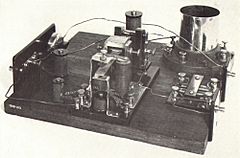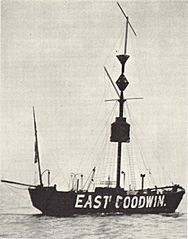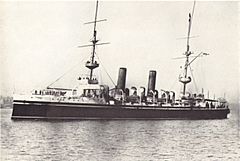Henry Jackson (Royal Navy officer) facts for kids
Quick facts for kids
Sir Henry Jackson
|
|
|---|---|

Admiral of the Fleet Sir Henry Jackson
|
|
| Born | 21 January 1855 Barnsley, Yorkshire |
| Died | 14 December 1929 (aged 74) Hayling Island, Hampshire |
| Allegiance | United Kingdom |
| Service/ |
Royal Navy |
| Years of service | 1868–1924 |
| Rank | Admiral of the Fleet |
| Commands held | First Sea Lord Royal Naval College, Greenwich 6th Cruiser Squadron HMS Vernon HMS DuncanHMS Vulcan HMS Juno |
| Battles/wars | Anglo-Zulu War First World War |
| Awards | Knight Grand Cross of the Order of the Bath Knight Commander of the Royal Victorian Order Grand Cross of the Order of Naval Merit (Spain) Grand Cordon of the Order of the Rising Sun (Japan) |
Admiral of the Fleet Sir Henry Bradwardine Jackson was a key officer in the Royal Navy. Born on January 21, 1855, he became famous for his amazing work with early wireless technology, which allowed ships to talk to each other without wires.
He was the first person to successfully send wireless messages between two ships. He even showed that ships could communicate continuously up to three miles apart! Later, he held very important jobs in the Navy, like being the Third Sea Lord and the Chief of the Admiralty War Staff. During the First World War, he helped plan attacks on Germany's colonies. He also became the First Sea Lord, which is one of the highest positions in the Royal Navy. Sir Henry Jackson passed away on December 14, 1929.
Contents
Henry Bradwardine Jackson was born in Barnsley, Yorkshire. He joined the Royal Navy as a young cadet in 1868 when he was just 13 years old. He trained on the ship HMS Britannia.
As a young officer, he served on different ships. He was promoted to sub-lieutenant in 1874 and later to lieutenant in 1877. He even saw action on land during the Anglo-Zulu War in 1879. After this, he went to a special school called HMS Vernon to learn about torpedoes. He became an expert in this area.
In 1890, Jackson became a commander. Five years later, he took charge of a training ship called HMS Defiance. It was here that he started to become known for his groundbreaking work with wireless technology. This was a very new idea at the time!
He was promoted to captain in 1896. He then made history by being the first person to send wireless messages between two ships. He showed that ships could talk to each other up to three miles away. Later, his experiments allowed messages to be sent over 140 miles! He also studied how land between ships affected these signals.
Jackson continued his work, even becoming the commanding officer of ships like HMS Juno and HMS Vulcan, which were both equipped with his wireless systems. He worked closely with the Marconi Company, a famous wireless company, to develop a wireless system for the entire Navy. His amazing achievements were recognized when he was made a Fellow of the Royal Society in 1901.
He continued to rise through the ranks. He became the Commanding Officer of the battleship HMS Duncan and later the Captain of the torpedo school HMS Vernon. In 1905, he became the Third Sea Lord, a very important role in the Navy. He was promoted to rear admiral in 1906.
In 1908, he commanded the 6th Cruiser Squadron in the Mediterranean Sea. He was also honored by Spain with the Grand Cross of the Order of Naval Merit. In 1911, he became a vice admiral and was appointed Director of the Royal Naval War College. By 1913, he was the Chief of the Admiralty War Staff. He became a full admiral in 1914, just as World War I was beginning. He advised on plans to attack Germany's colonies overseas.
Becoming First Sea Lord
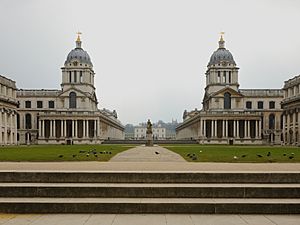
In May 1915, Sir Henry Jackson was chosen for a very important role: First Sea Lord. This was a surprise appointment after the previous First Sea Lord, Lord Fisher, resigned. Lord Fisher's resignation followed the difficulties of the Gallipoli Campaign, a major military operation during World War I.
Jackson worked well with Arthur Balfour, who was the First Lord of the Admiralty (a top government official for the Navy). However, Jackson mainly focused on managing the Navy's daily operations. His reputation suffered when German destroyers appeared in the English Channel, causing concern. Because of this, he was replaced by Sir John Jellicoe in December 1916. Jackson was recognized for his service with the Knight Grand Cross of the Order of the Bath.
Later Life and Achievements
After leaving the First Sea Lord role, Jackson became the President of the Royal Naval College, Greenwich in December 1916. He received another honor, the Grand Cordon of the Japanese Order of the Rising Sun, in 1917.
On July 31, 1919, he reached the highest rank in the Navy: Admiral of the Fleet. He retired from the Royal Naval College shortly after.
Even in retirement, he continued his scientific work. In 1920, he became the first Chairman of the Radio Research Board. In 1926, he won the Hughes Medal from the Royal Society. This award was given for his amazing "pioneer work in the scientific investigations of radiotelegraphy and its application to navigation." This means his early work with wireless technology was still making a big impact.
In the 1920s, he also helped Winston Churchill, who later became Prime Minister, by checking facts for Churchill's books about World War I.
Sir Henry Jackson died at his home in Hayling Island, Hampshire, on December 14, 1929.
Family Life
In 1890, Henry Jackson married Alice Burbury. Her father was Samuel Hawksley Burbury, who was also a Fellow of the Royal Society. Henry and Alice did not have any children.


